 Many thanks to SWLing Post contributor, Paul Evans, who notes that the Radio Society of Great Britain has made the July 2020 issue of the bi-monthly RadCom Basics free to download.
Many thanks to SWLing Post contributor, Paul Evans, who notes that the Radio Society of Great Britain has made the July 2020 issue of the bi-monthly RadCom Basics free to download.
Click here to check out the July 2020 edition on the RSGB website.

 Many thanks to SWLing Post contributor, Paul Evans, who notes that the Radio Society of Great Britain has made the July 2020 issue of the bi-monthly RadCom Basics free to download.
Many thanks to SWLing Post contributor, Paul Evans, who notes that the Radio Society of Great Britain has made the July 2020 issue of the bi-monthly RadCom Basics free to download.
Click here to check out the July 2020 edition on the RSGB website.
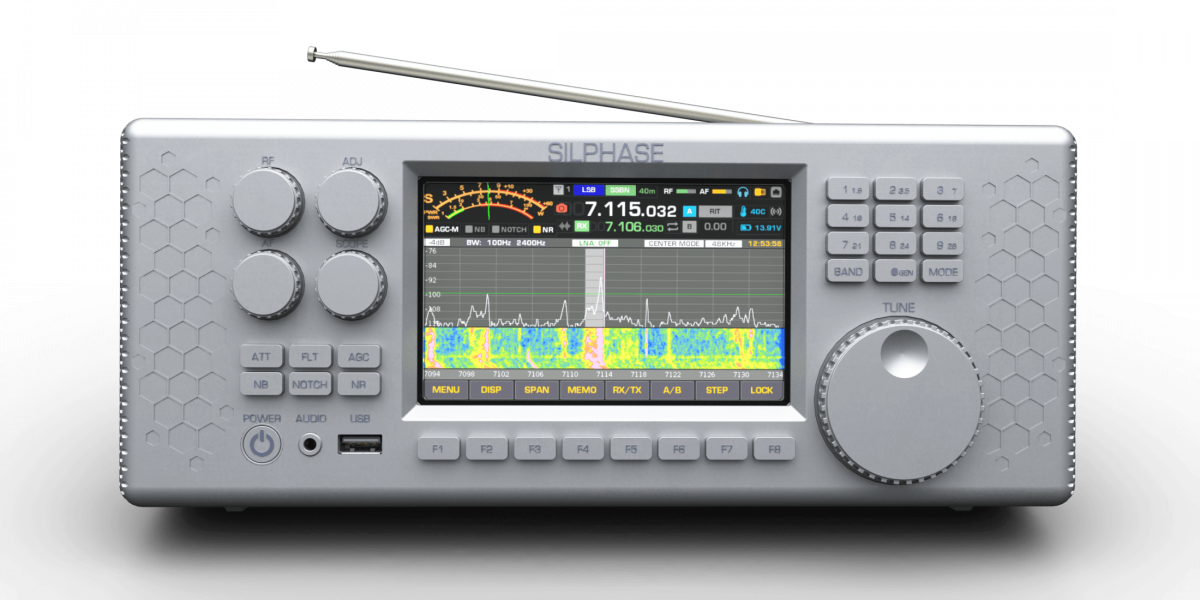
I’ve just learned about a new SDR receiver in development by the Polish company Silphase. It’s called the Silphase R1 and appears to be a stand-alone, high-performance SDR receiver.
What could set this receiver apart from the rest is the:
The receiver is portable and will measure 11.25×4.3×2.2in (285×110×55mm). Looks like the screen will be 5″ which should allow for a detailed spectrum viewing area (for comparison, the Icom IC-7300 TFT display is 4.3″)
Siphase is a new company based in Poland and they claim they also plan to eventually produce transceivers:
“At the end of 2020 we will introduce a 25W transceiver in the same form factor powered by an internal battery, and a bit little later a 100W transceiver in the same form factor also powered by an internal battery.”
The Silphase product page has a complete list of specifications, but here are some worth noting:
As I learn more about this receiver and the company producing it, I’ll post updates with the tag: Silphase R1
Click here to check out the Silphase website.
Please consider supporting us via Patreon or our Coffee Fund!
Your support makes articles like this one possible. Thank you!
One of the most amazing things about hosting and curating a massive collection of shortwave radio recordings is listening to each recording as they’re published on the Shortwave Radio Audio Archive (SRAA).
SRAA contributor, Tom Gavaras, has shared some brilliant off-air and studio recordings over the years including the following shortwave recording of Voyager Experimental Aircraft flight communications with Dick Rutan and Jeana Yeager in 1986.
I haven’t even published the recording on the archive yet, as he just submitted it. Tom notes:
Rutan Model 76 Voyager Experimental Aircraft was the first aircraft to fly around the world without stopping or refueling.
It was piloted by Dick Rutan and Jeana Yeager.
The flight took off from Edwards Air Force Base’s runway in the Mojave Desert on December 14, 1986, and ended 9 days later on December 23, setting a flight endurance record.
This shortwave recording is a sample of some of the communications between Dick Rutan and his ground crew including a debate if Dick should walk out of the aircraft after it lands.
Tom made this recording with an ICOM R71A receiver in Minnetonka, MN, and believes the date of this recording is December 22, 1986:
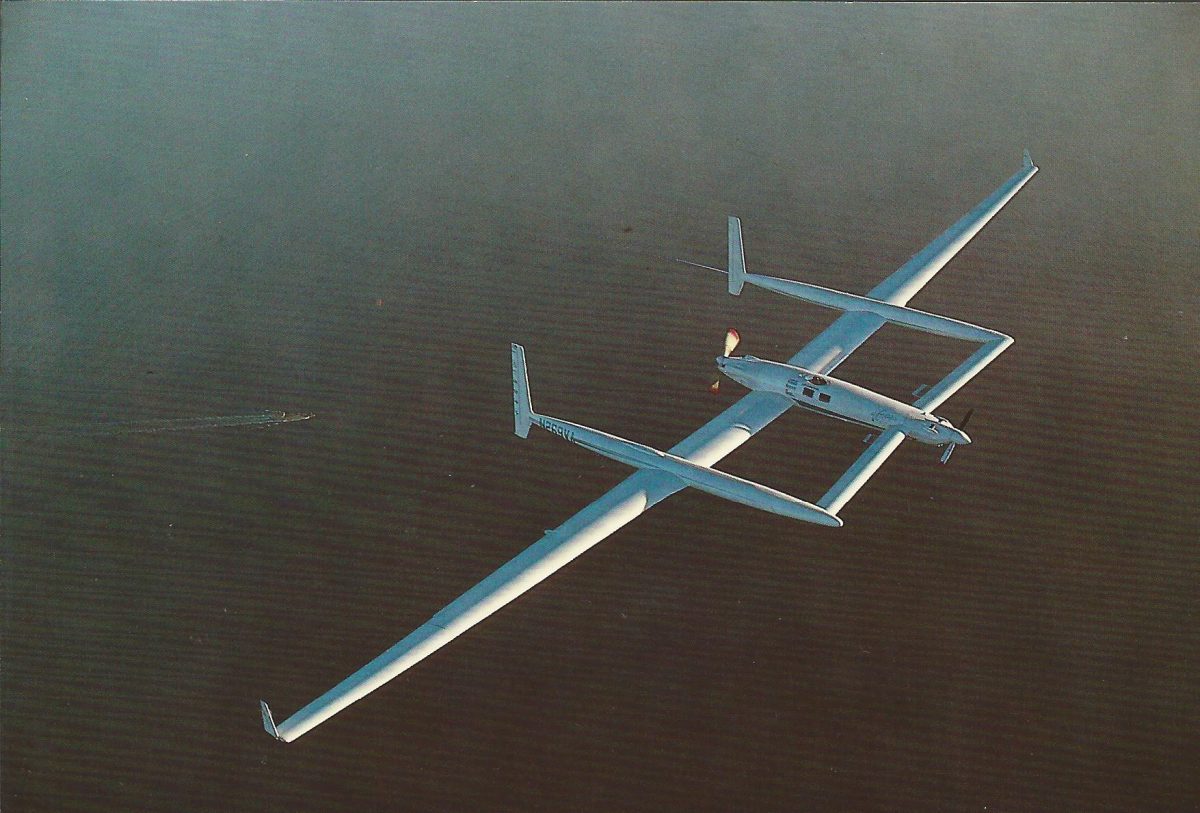
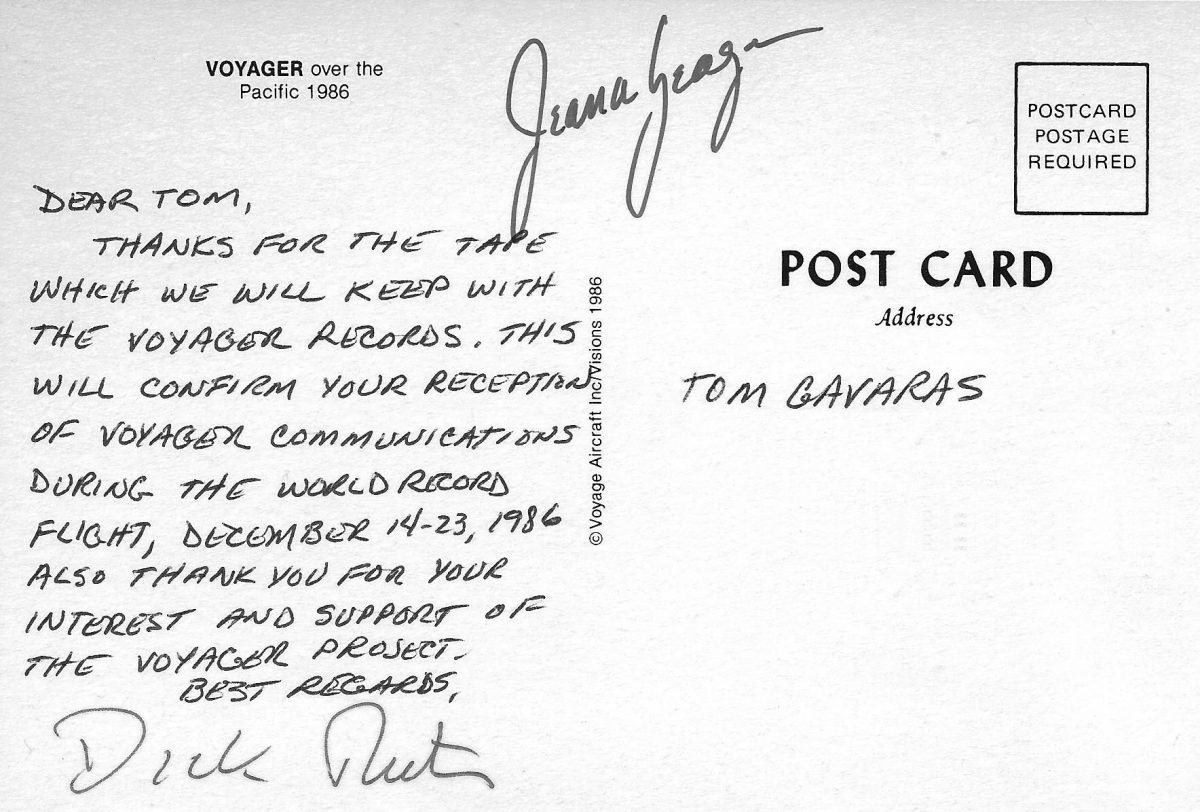 This is simply amazing, Tom! Thank you so much for sharing your recording and QSL card with us. A proper radio treasure!
This is simply amazing, Tom! Thank you so much for sharing your recording and QSL card with us. A proper radio treasure!
Post readers: click here to check out the Shortwave Radio Audio Archive and click here to browse some of Tom’s contributions. Also, click here to read our previous post about Tom’s amazing RadioTapes.com website.
 Radio Waves: Stories Making Waves in the World of Radio
Radio Waves: Stories Making Waves in the World of RadioBecause I keep my ear to the waves, as well as receive many tips from others who do the same, I find myself privy to radio-related stories that might interest SWLing Post readers. To that end: Welcome to the SWLing Post’s Radio Waves, a collection of links to interesting stories making waves in the world of radio. Enjoy!
Many thanks to SWLing Post contributors Mike Terry, Dan Robinson, Ulis Fleming, and William Lee for the following tips:
GENEVA — Switzerland is embarking on the next phase of its digital radio switchover strategy. In May René Wehrlin, media specialist at Switzerland’s Federal Office of Communications (Ofcom) announced the country’s next steps toward the country’s total transition to DAB+.
Ofcom officially confirmed in 2019 that the nation would say “adios” to all FM radio programs by the end of 2024 at the latest. At the time, the “Digital Migration” (DigiMig) working group, set up by the Swiss private and public radio sectors and Ofcom in 2013, stated that 68% of radio listening was digital, 37% of which was via DAB+ and 15% exclusively via FM.[…]
Guyana’s President David Granger late Friday said his administration rejected a request by the United States (US) to use the medium wave radio frequencies of this South American nation to broadcast Voice of America programmes to Venezuela.
Mr. Granger said Guyana turned down the request because of security, health and political risks that Guyana could expose itself to with Venezuela which is claiming the Essequibo Region that makes up about two-thirds of this former British colony.
“Given the length of an unpoliced western border, the influx of refugees, the unsettled territorial question and the public health risks, it would not be in our national interest to do anything to contribute to destabilising relations at this time,” the President said.
A US Embassy spokeswoman said the American government was no longer interested in the project. ” The U.S Agency for Global Media is not actively considering this anymore. It is important that the people of Venezuela have access to uncensored news from credible Venezuelan and international journalistic news sources. Guyana has shown leadership in the past, in defense of representative government by joining other Lima Group members from the Americas to strive for a democratic resolution to the crisis in Venezuela,” she said.[…]
The Chinese navy has warned off a US military plane that briefly flew close to the southern coast of China, north of the Taiwan Strait, according to a Beijing-based think tank.
In a 34-second scratchy radio recording released by the South China Sea Strategic Situation Probing Initiative (SCSPI), a think tank based in Beijing, a man – purported to be a Chinese naval official – can be heard saying in English: “This is China Naval Air Force on guard, you are approaching Chinese air domain, change your course immediately or you will be intercepted.”
He then repeated the warning in Mandarin Chinese.The institute said on its Twitter account that the recording was captured on Thursday morning by a radio amateur. It remains unclear which aircraft was involved, or if there was any face-off in the air.[…]
Charity Intelligence is recommending donors support Farm Radio International for the coronavirus pandemic. Farm Radio has a network of over 1,000 radio programs reaching more than 250 million people in 41 countries across Africa.
To donate to Farm Radio’s covid-response
Communication is critical in the early stages of a disease outbreak to give people information. Rumours swirl that Africans cannot get coronavirus. Tanzania’s president, Magufuli, said churches should stay open because the coronavirus is “satanic” and “cannot survive in the body of Christ.” As all have witnessed, fake news has harmful consequences with the quick coronavirus.
Farm Radio International is a Canadian, medium-sized charity with donations of $3.9m in 2018. Typically, a charity of this size would not be front of mind in a global response. Yet Farm Radio has the existing platform and local operations to play an effective role reaching millions quickly in a coronavirus response. Early communication is an urgent need. […]
Please consider supporting us via Patreon or our Coffee Fund!
Your support makes articles like this one possible. Thank you!
I mentioned in a previous post that one of my Social DX goals was to activate a Parks On The Air (POTA) site in CW (Morse Code).
Mission accomplished!
Yesterday, I mustered up the nerve and drove to the Blue Ridge Parkway (site K-3378 in POTA).
My wife and kids were knee-deep in another project so I planned to go solo until my dog, Hazel, caught wind I was leaving with my radio backpack in-tow. Always ready for a hike or road trip, she jumped in the car the moment I opened the door.
I’ll admit it: I was nervous. I had the same jitters I had the first time I spoke in front of a large crowd.
In the end, though, I really had nothing to fear. The POTA community is a very kind, courteous, cohesive and supportive group of radio operators.
I picked the Blue Ridge Parkway as my first site not only because it’s so convenient to where I live, but it’s also one of the most activated parks in the POTA program. I knew a BRP activation wouldn’t attract a mad pile-up of park hunters because everyone in POTA has this one in the books already.
My full radio kit–including my KX2 transceiver, KXPA100 100W amplifier, two antennas, Heil headset, two battery packs, chargers, and all accessories–is packed in my Red Oxx C-Ruck and always ready for action. I grabbed the full kit, although in truth I only needed the KX2, my CW paddles, coax cable and antenna.
Conditions were rough yesterday. Propagation was pretty good, but there were pop-up thunderstorm everywhere in the region, so the bands were very noisy with constant static crashes. Herein lies one of the great things about CW: you can use a filter width so narrow that it doesn’t affect you as much as it does operating phone.
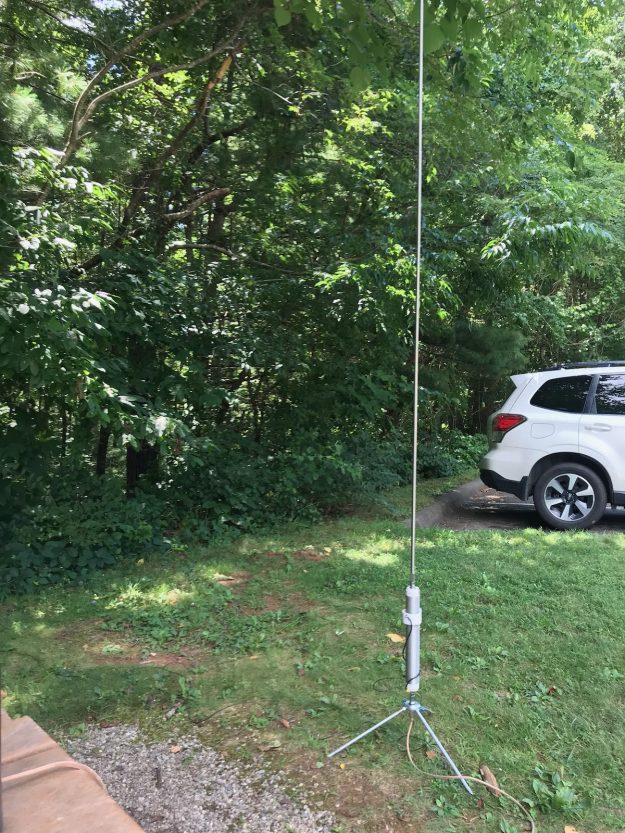
Because I had limited operating time, I deployed the Wolf River Coils TIA portable antenna. It takes me all of 4 minutes to set up.
I got on 40 meters, started calling “CQ POTA” and the next thing I know I had 13 stations logged.
My nerves dissipated quickly after I logged the first couple of contacts and I was even looking forward to stations answering my call. The operators were also incredibly patient with me and two of them even followed me to higher bands and made contact there.
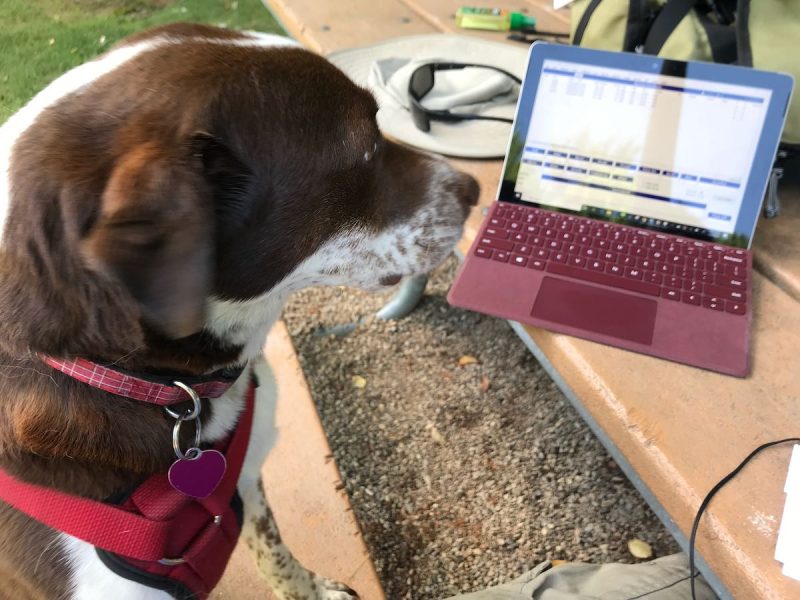
Hazel was a bit upset this activation didn’t include a hike, so several times she insisted on “helping” with the logs as I sweated it out!
All-in-all, I logged 17 stations in one hour on three bands using about 10 watts of power.
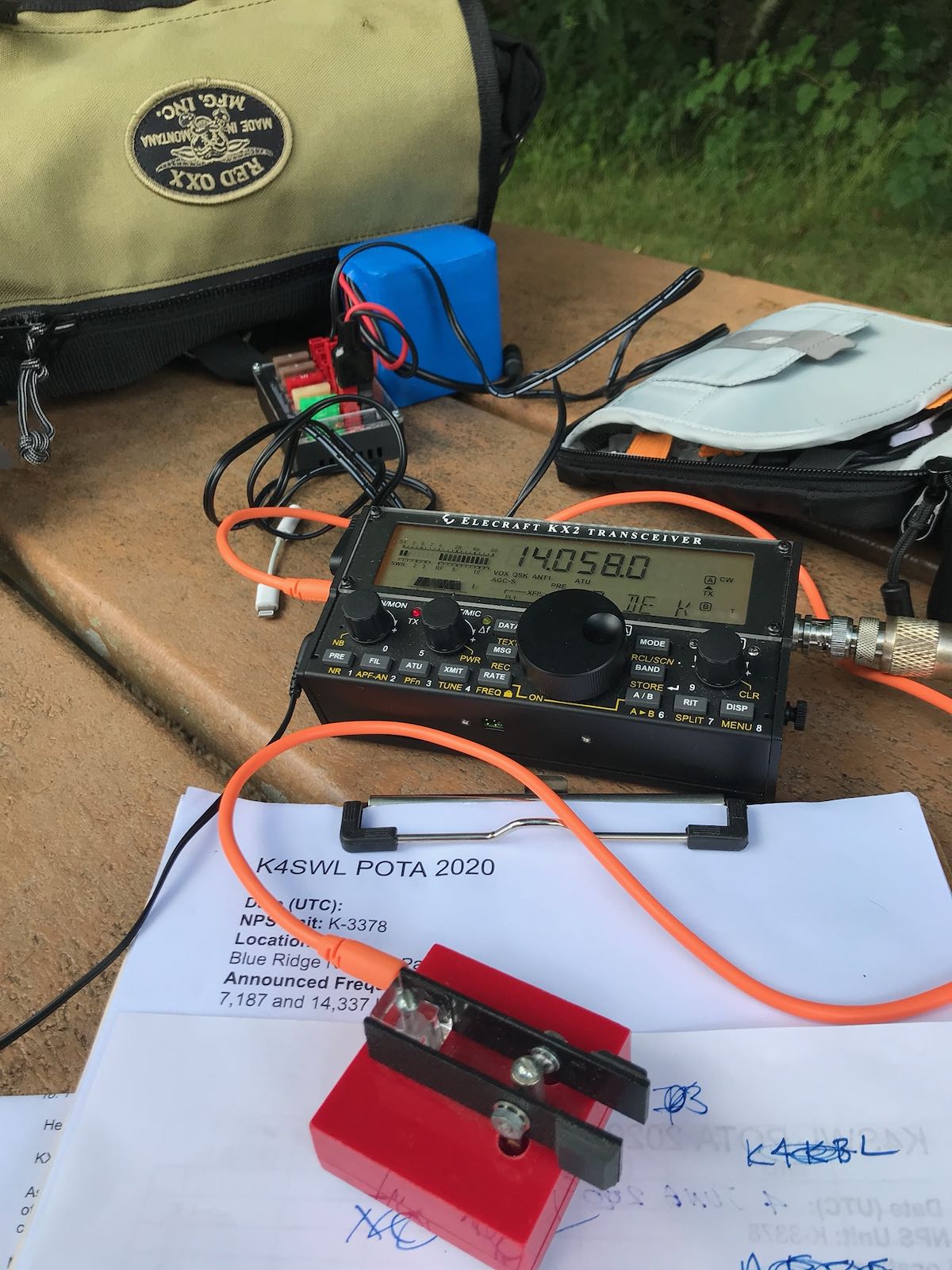 I deployed my station quickly, and I packed it up quickly. A pop-up thunderstorm, once again, chased me off the air. That’s okay, though, because I was already feeling pretty chuffed about bagging my first CW activation.
I deployed my station quickly, and I packed it up quickly. A pop-up thunderstorm, once again, chased me off the air. That’s okay, though, because I was already feeling pretty chuffed about bagging my first CW activation.
If I’m being completely honest here in front of my community of radio enablers, as soon as I arrived back home, I started mentally putting together a super-compact CW activation kit built around an LnR Precision MTR3B transceiver. I’ve always wanted one of these little CW-only transceivers to carry in my EDC bag for impromptu field radio fun, but never could justify it. Until now! 🙂
Please consider supporting us via Patreon or our Coffee Fund!
Your support makes articles like this one possible. Thank you!
Many thanks to SWLing Post contributor, Adrian Korol, who shares the following announcement:
RAE Argentina to the World, broadcasting from Antarctica
RAE will join a trial transmission by LRA36 Radio Nacional Arcangel San Gabriel, broadcasting from Base Esperanza, in the Argentine zone of Antarctica.
This Saturday, July 25, between 17:00 and 21:00 UTC, the Antarctic station will perform a series of tests on the 15476 kHz frequency (19-meter band), Upper Side Band, via a Collins HF80 transmitter and a rhombic antenna.
RAE Argentina al Mundo will put on the air two 30-minute programs, one in Spanish and the other in English, hosted by Fernando Farias, focusing on the history of RAE and LRA36 with historical files and information that listeners, DXers and radio amateurs alike will appreciate. On the Spanish-language show, Fernando is joined by RAE’s director Adrián Korol.
Let’s recall that last Saturday, July 18th, the first test USB transmissions were carried out with excellent results amid optimal broadcast conditions .
Damian Tranamil, LRA36 operator and technician, answered afterwards more than a hundred reception reports from all over the World.
Many listeners said they had the chance to pick up a station from Antarctica for the first time, while others said they were thrilled to be able to receive Arcángel San Gabriel’s signal for the first time in 20 years.
Accurate reception reports will be verified with an electronic QSL card (eQSL). They are to be sent to : [email protected]
We also appreciate listeners sending clips of them receiving our broadcast, or tagging us when they post on social media.
Many thanks to Boris (LZ2JR/AC9IJ) who notes that his company, Mobimax, in Europe now distributes the excellent Belka-DSP receiver.
Boris informed me that he has inventory and they ship immediately (at time of posting–July 25, 2020).
The price is 145.72 EUR (roughly $170 US).
They have two shipping options to US:
Click here to check out the product page.
I’ve been working with Boris for well over a year now. He’s the designer and developer behind the Mission RGO One transceiver project. He’s a top-notch fellow and provides excellent customer service to his clients (check out what reviewers say about him on eHam).
Click here to check out Dan Robinson’s initial Belka-DSP review,